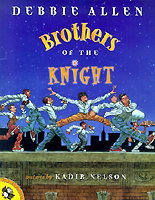|
|
|
|
|
|
|

| 최근 이 책을 구매하신 다른 회원의 책장 |
|
 |
|
|
|
[ 책 소개 ]
"Moses"와 "Henry's Freedom Box"로 2차례 Caldecott 상을 받은 저명한 아티스트 카디르 넬슨의 대표작 중 하나입니다. 유명한 전래동화인 "The Twelve Dancing Princesses"를 현대적인 시대배경으로 재구성한 재미있는 내용입니다.
미국 뉴욕시의 할렘지역에 사는 나이트 목사는 지역사회에서 존경을 받는 리더이며, 12명의 아들을 둔 아버지 이기도 합니다. 그런데 아침이 되면 12명 아들의 운동화가 너덜너덜 헤지고 닳아 있었습니다. 나이트 목사는 집에서 기르는 커다란 개 해피가 밤새도록 운동화를 물어뜯은 거라고 생각했습니다. 하지만 사실은 그렇지 않았지요. 12명의 아이들은 밤이 되면 창문을 통해 밖으로 나가서 밤새도록 친구들과 신나게 춤을 추다가 돌아오곤 했던 겁니다. 아이들은 지역사회에서 존경받는 아빠가 자신들 때문에 위신이 깎일까봐 이 사실을 비밀로 하고 있었어요. 그런데 나이트 목사가 새로 고용한 유모가 밤에 몰래 아이들 뒤를 쫓아갔다가 이 사실을 알게 되고...
[ 관련 동영상 보기 ]
 ▶
[ 서지 정보 ]
Paperback: 40 pages
ISBN-10: 0142300160
ISBN-13: 978-0142300169
책 크기: 27.8 cm x 21.5 cm
[ 영문 서평 ]
Book Description
Debbie Allen's contemporary retelling of the classic tale The Twelve Dancing Princesses with illustrations from Kadir Nelson!
Reverend Knight can't understand why his twelve sons' sneakers are torn to threads each and every morning, and the boys aren't talking. They know their all-night dancing wouldn't fit with their father's image in the community. Maybe Sunday, a pretty new nanny with a knack for getting to the bottom of household mysteries, can crack the case. This modern, hip retelling of the classic tale The Twelve Dancing Princesses bursts with vibrant artwork and text that's as energetic as the twelve toe-tapping Knight brothers themselves.
Publishers Weekly
The Twelve Dancing Princesses have nothin' on the 12 sons of Reverend Knight, a Harlem preacher. Narrating the tale in a chatty if somewhat rambling voice, the family dog, Happy, explains that this man "raised his sons with a firm, loving hand... but a lot was goin' on that couldn't be explained." Actress, choreographer and producer Allen gives a familiar tale a hip spin as the brothers dance each night from one roof to the next to reach the Big Band Ballroom. There they swing till dawn, returning home with shoes "worn to threads, messed up, torn up, stinky, dirty, tacky, jacked up." Sunday, a sharp, attractive housekeeper with magical powers, discovers the siblings' secret, but she keeps mum, waiting instead until the kids themselves are ready to 'fess up to their dad. They don't and she quits, but all ends happily. Successfully capturing the energy of the swirling, twirling nighttime revelers, first-time children's book artist Nelson's sepia-toned illustrations possess the precision of line accorded to pen-and-inks, filled out with a full palette of oil paints. He's equally adept with the interiors of the church as with rooftop scenes of the boys whooping it up under starlit skies. A funky, fresh adaptation.
School Library Journal
A spin-off of the Grimm tale, "The Twelve Dancing Princesses," this is the story of Preacher Knight and his attempts to solve the mystery of the worn-out sneakers he finds in his sons' room each morning. Believing that their father would not approve of their clandestine dancing at the Big Band Ballroom, the 12 boys refuse to confide in him. Only when the ingenious housekeeper, Sunday, attempts to reveal the brothers' secret is Reverend Knight's own predilection for dancing disclosed and the family-along with the bewitching Sunday-reconciled. The setting for Allen's fresh imagining is "a little village called Harlem." Her hip text is given spark and personality through the use of contemporary dialect: Sunday's cookies " were jump up and down, slap yo' own self in the face good!" The humor of the story is heightened by the artwork. Nelson's pencil drawings were photocopied and then painted in oils, producing a fine line, minutely detailed characters and settings, and expressively lit coloration. The strutting, high-stepping brothers are full of individuality, attitude, and movement. Text is boxed with old frayed sneakers and laces. Few elements of the Grimm tale remain, except the worn shoes, the illicit dancing, the outsider who solves the mystery, and the cloak of invisibility. However, new elements, such as the gender change and the brothers' motivation for secrecy, fit neatly. The choice of the family dog as narrator is the only false note. His expository remarks, though humorous, sometimes interrupt the flow. Still, don't let this small flaw keep this original title off your dance card.
|
|
|
|
|
|
|
|
|
| |
| |
| |
| |
| |
| |
|
|
Imagine
ABPA. Design Award..
3,400원 | | |
| |
|
|
|
|
|